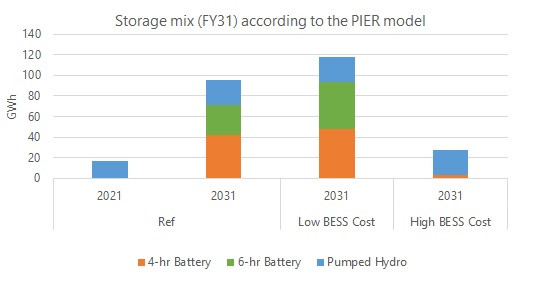Preparing for significant expansion of storage in the Indian grid
There has been a strong policy push to significantly scale up the solar and wind capacity in the Indian grid by 2030 and beyond. Srihari Dukkipati, Research Fellow at Prayas (Energy Group) takes a look at the challenges of reliably meeting demand, and the complementary role that storage can play.
With solar and wind generation costs falling below those of new coal-based generation, and given that solar and wind are more environmentally benign than coal, the Indian government is putting its might behind scaling up the renewables mix in the Indian grid.
While this bodes well for meeting our green energy targets, it also brings up the challenge of meeting demand reliably, since solar and wind generation may not coincide with demand.
These challenges can be addressed through:
- flexible operation of coal generation fleet as needed,
- using peaking generation such as hydro and gas during high net load periods,
- shifting load to periods with high solar and wind generation, e.g., meeting farm pumping demand using distributed solar plants connected to agricultural feeders,
- better price signals through time-of-day pricing to reflect system cost,
- use of storage to shift generation from low net load periods to high net load periods, and
- using larger balancing areas for system operation.
With battery storage prices expected to drop significantly in the coming decade, the focus has been on the complementary role that storage can play in a grid with high penetration of renewables. At Prayas (Energy Group), we recently investigated the role of storage in the Indian grid over the current decade, up to 2030-31, as part of a couple of modelling studies.
The first study is based on an open energy systems model for India named PIER (Perspectives on Indian Energy based on Rumi), which estimates spatially and temporally disaggregated demand up to 2030-31, and meets that demand through optimization of various supply choices including production and import of primary fuels, the addition of electricity generation and storage capacities and transfers across different regions. Currently, residential demand is estimated bottom-up based on energy service needs, by type of consumer classified into urban and rural, and by expenditure quintiles.
(The model results are described in detail in a report titled 'PIER: Modelling the Indian energy system through the 2020s', and input and output data are available for free download and use on GitHub.)
In the reference scenario, it is cost-effective to have about 420GW of solar and wind capacity and 70GWh of battery storage by FY31. If battery storage prices drop faster than assumed in the reference scenario, more than 90GWh of battery storage gets added. If battery storage prices drop slower than assumed, no battery storage gets added by FY31. However, there is widespread agreement among analysts that prices will certainly drop; it is only a matter of how soon.
The second study is based on a State-level power sector production cost simulation model for the State of Maharashtra. This model, developed using the open-source and feature-rich GridPath platform, simulates unit commitment and economic dispatch for the region served by MSEDCL, the State distribution utility. Dispatch happens in 15-minute blocks, and operational constraints such as ramp rates, technical minimum, start costs, and minimum up and downtimes are honored in each block.
Demand and RE generation profiles are as reported by SLDC in the year 2017-18, with the demand profile being modified to shift about 50 percent of the non-monsoon night time agriculture load to day time in line with Maharashtra's solar agriculture feeder scheme. The model compares system operation across different capacity mix scenarios, provided exogenously to the model, ranging from 30 percent to 50 percent of the demand being met through RE sources in FY30. In the 30 percent RE scenario, 3GW of coal-based capacity is added to meet demand reliably, whereas in the 50 percent RE scenario, 28GWh of battery storage is added.
It is found that demand can be met reliably and cost-effectively with 50 percent of the demand being met through RE sources, and with no net coal-based capacity addition. Storage plays an important role in making this happen, and the 50 percent RE scenarios result in slightly lower total generation cost (including RE and storage fixed costs) compared with the 30 percent RE scenario.
There are advantages to battery storage beyond balancing generation at a utility-scale. The modular nature of battery storage makes it suitable for providing balancing and stability support at multiple levels of the distribution and transmission network. Co-locating battery storage with solar could result in additional savings in the balance of system costs as well as better utilization of transmission lines. Hence, there is a strong case for preparing for the inevitable increase in grid-level storage in the Indian electricity grid.
It is found from the PIER study that battery storage starts becoming cost-effective for the Indian grid by 2027-28, so significant capacity is likely to be added starting then. There are multiple potential applications of battery storage, and different possible procurement arrangements such as bulk procurement, ancillary services, deferring transmission investments, and reliability support for critical loads. Given this, these different options must be experimented with through pilots in a methodical manner over the next five years to figure out what works and what does not. Utilities, regulators, planners, and system operators can play a crucial role in evaluating these pilots. These learnings will help provide useful inputs for the subsequent expansion in scale, which appears to be inevitable.
(Srihari Dukkipati works on energy models and data at Prayas (Energy Group), which is an Indian research and analysis organization working in the area of energy policy. It is part of a non-government charitable trust called 'Prayas', in Pune.)

























